Antiresonant Reflecting Guidance and Mach-Zender Interference in Cascaded Hollow-Core Fibers for Multi-Parameter Sensing
Abstract
:1. Introduction
2. Principle and Spectral Characteristics
3. Multi-Parameter Sensing
3.1. Simultaneously Sensing of Temperature and Strain
3.2. Pressure Sensing under Different Temperature
4. Conclusions
Author Contributions
Funding
Conflicts of Interest
References
- Rugeland, P.; Sterner, C.; Margulis, W. Visible light guidance in silica capillaries by antiresonant reflection. Opt. Express 2013, 21, 29217–29222. [Google Scholar] [CrossRef] [PubMed]
- Lai, C.H.; Chang, T.; Yeh, Y.S. Characteristics of bent terahertz antiresonant reflecting pipe waveguides. Opt. Express 2014, 22, 8460–8472. [Google Scholar] [CrossRef] [PubMed]
- Zhang, X.; Pan, H.; Bai, H.; Yan, M.; Wang, J.; Deng, C.; Wang, T. Transition of Fabry–Perot and antiresonant mechanisms via a SMF-capillary-SMF structure. Opt. Lett. 2018, 43, 2268–2271. [Google Scholar] [CrossRef] [PubMed]
- Malka, D.; Sintov, Y.; Zalevsky, Z. Prospects for diode-pumped alkali-atom-based hollow-core photonic-crystal fiber lasers. Opt. Lett. 2014, 39, 4655–4658. [Google Scholar]
- Sollapur, R.; Kartashov, D.; Zürch, M.; Hoffmann, A.; Grigorova, T.; Sauer, G.; Hartung, A.; Schwuchow, A.; Bierlich, J.; Kobelke, J.; et al. Resonance-enhanced multi-octave supercontinuum generation in antiresonant hollow-core fibers. Light Sci. Appl. 2017, 124, e17124. [Google Scholar] [CrossRef] [PubMed]
- Liu, S.; Wang, Y.; Hou, M.; Guo, J.; Li, Z.; Lu, P. Anti-resonant reflecting guidance in alcohol-filled hollow core photonic crystal fiber for sensing applications. Opt. Express 2013, 21, 31690–31697. [Google Scholar] [CrossRef] [PubMed]
- Gao, R.; Lu, D.F.; Cheng, J.; Jiang, Y.; Jiang, L.; Ye, J.S.; Qi, Z.M. Magnetic fluid-infiltrated anti-resonant reflecting optical waveguide for magnetic field sensing based on leaky modes. J. Lightw. Technol. 2016, 34, 3490–3495. [Google Scholar] [CrossRef]
- Gao, R.; Lu, D.F.; Cheng, J.; Qi, Z.M. Self-referenced antiresonant reflecting guidance mechanism for directional bending sensing with low temperature and strain crosstalk. Opt. Express 2017, 25, 18081–18091. [Google Scholar] [CrossRef] [PubMed]
- Gao, R.; Lu, D.F.; Cheng, J.; Zhang, M.Y.; Qi, Z.M. Optofluidic immunosensor based on resonant wavelength shift of a hollow core fiber for ultratrace detection of carcinogenic benzo [a] pyrene. ACS Photonics 2018, 5, 1273–1280. [Google Scholar] [CrossRef]
- Malka, D.; Katz, G. An Eight-Channel C-Band Demux Based on Multicore Photonic Crystal Fiber. Nanomaterials 2018, 8, 845. [Google Scholar] [CrossRef] [PubMed]
- Gao, R.; Jiang, Y.; Zhao, Y. Magnetic field sensor based on anti-resonant reflecting guidance in the magnetic gel-coated hollow core fiber. Opt. Lett. 2014, 39, 6293–6296. [Google Scholar] [CrossRef] [PubMed]
- Liu, S.; Ji, Y.; Cui, L.; Sun, W.; Yang, J.; Li, H. Humidity-insensitive temperature sensor based on a quartz capillary anti-resonant reflection optical waveguide. Opt. Express 2017, 25, 18929–18939. [Google Scholar] [CrossRef] [PubMed]
- Huang, M.; Yang, C.; Sun, B.; Zhang, Z.; Zhang, L. Ultrasensitive sensing in air based on graphene-coated hollow core fibers. Opt. Express 2018, 26, 3098–3107. [Google Scholar] [CrossRef] [PubMed]
- Hou, M.; Zhu, F.; Wang, Y.; Wang, Y.; Liao, C.; Liu, S.; Lu, P. Antiresonant reflecting guidance mechanism in hollow-core fiber for gas pressure sensing. Opt. Express 2016, 24, 27890–27898. [Google Scholar] [CrossRef] [PubMed]
- Hou, M.; Wang, Y.; Liu, S.; Li, Z.; Lu, P. Multi-components interferometer based on partially filled dual-core photonic crystal fiber for temperature and strain sensing. IEEE Sens. J. 2016, 16, 6192–6196. [Google Scholar] [CrossRef]
- Ni, W.; Lu, P.; Zhang, J.; Yang, C.; Fu, X.; Sun, Y.; Liu, D. Single hole twin eccentric core fiber sensor based on anti-resonant effect combined with inline Mach-Zehnder interferometer. Opt. Express 2017, 25, 12372–12380. [Google Scholar] [CrossRef] [PubMed]
- Ni, W.; Lu, P.; Fu, X.; Sun, H.; Shum, P.P.; Liao, H.; Lian, Z. Simultaneous implementation of enhanced resolution and large dynamic range for fiber temperature sensing based on different optical transmission mechanisms. Opt. Express 2018, 26, 18341–18350. [Google Scholar] [CrossRef] [PubMed]
- Chen, P.; Dai, Y.; Zhang, D.; Wen, X.; Yang, M. Cascaded-Cavity Fabry-Perot Interferometric Gas Pressure Sensor based on Vernier Effect. Sensors 2018, 18, 3677. [Google Scholar] [CrossRef] [PubMed]
- Birch, K.P.; Downs, M.J. An updated Edlén equation for the refractive index of air. Metrologia 1993, 30, 155–162. [Google Scholar] [CrossRef]
- Liang, H.; Jia, P.; Liu, J.; Fang, G.; Li, Z.; Hong, Y.; Xiong, J. Diaphragm-Free Fiber-Optic Fabry-Perot Interferometric Gas Pressure Sensor for High Temperature Application. Sensors 2018, 18, 1011. [Google Scholar] [CrossRef] [PubMed]
- Wang, Y.; Wang, D.N.; Wang, C.; Hu, T. Compressible fiber optic micro-Fabry-Pérot cavity with ultra-high pressure sensitivity. Opt. Express 2013, 21, 14084–14089. [Google Scholar] [CrossRef] [PubMed]
- Talataisong, W.; Wang, D.N.; Chitaree, R.; Liao, C.R.; Wang, C. Fiber in-line Mach–Zehnder interferometer based on an inner air-cavity for high-pressure sensing. Opt. Lett. 2015, 40, 1220–1222. [Google Scholar] [CrossRef] [PubMed]
- Xu, B.; Wang, C.; Wang, D.N.; Liu, Y.; Li, Y. Fiber-tip gas pressure sensor based on dual capillaries. Opt. Express 2015, 23, 23484–23492. [Google Scholar] [CrossRef] [PubMed]
- Choi, H.Y.; Park, K.S.; Park, S.J.; Paek, U.C.; Lee, B.H.; Choi, E.S. Miniature fiber-optic high temperature sensor based on a hybrid structured Fabry–Perot interferometer. Opt. Lett. 2008, 33, 2455–2457. [Google Scholar] [CrossRef] [PubMed]
- Tervonen, A.; Poyhonen, P.; Honkanen, S.; Tahkokorpi, M. Guided-Wave Mach- Zehnder Interferometer Structure for Wavelength Multiplexing. IEEE Photonic Technol. Lett. 1991, 3, 516–518. [Google Scholar] [CrossRef]
- Litchinitser, N.M.; Abeeluck, A.K.; Headley, C.; Eggleton, B.J. Antiresonant reflecting photonic crystal optical waveguides. Opt. Lett. 2002, 27, 1592–1594. [Google Scholar] [CrossRef] [PubMed]
- Gao, R.; Lu, D.; Cheng, J.; Qi, Z.M. In-Fiber Double-Layered Resonator for High-Sensitive Strain Sensing. IEEE Photonics Technol. Lett. 2017, 29, 857–860. [Google Scholar] [CrossRef]
- Liu, S.; Tian, J.; Wang, S.; Wang, Z.; Lu, P. Anti-Resonant Reflecting Guidance in Silica Tube for High Temperature Sensing. IEEE Photonics Technol. Lett. 2017, 29, 2135–2138. [Google Scholar] [CrossRef]
- Li, E. Temperature compensation of multimode-interference-based fiber devices. Opt. Lett. 2007, 32, 2064–2066. [Google Scholar] [CrossRef] [PubMed]
- Chen, C.; Yu, Y.; Zhang, X.; Yang, R.; Zhu, C.; Wang, C.; Xue, Y.; Zhu, F.; Chen, Q.; Sun, H. Compact fiber tip modal interferometer for high-temperature and transverse load measurements. Opt. Lett. 2013, 38, 3202–3204. [Google Scholar] [CrossRef] [PubMed]
- Li, Z.; Liao, C.; Wang, Y.; Xu, L.; Wang, D.; Dong, X.; Liu, S.; Wang, Q.; Yang, K.; Zhou, J. Highly-sensitive gas pressure sensor using twin-core fiber based in-line Mach-Zehnder interferometer. Opt. Express 2015, 23, 6673–6678. [Google Scholar] [CrossRef] [PubMed]
- Hauf, W.; Grigull, U. Optical methods in heat transfer. Adv. Heat Transf. 1970, 6, 133–366. [Google Scholar]
- Sang, B.H.; Jeon, T.I. Pressure-dependent refractive indices of gases by THz time-domain spectroscopy. Opt. Express 2016, 24, 29040–29047. [Google Scholar] [CrossRef] [PubMed]

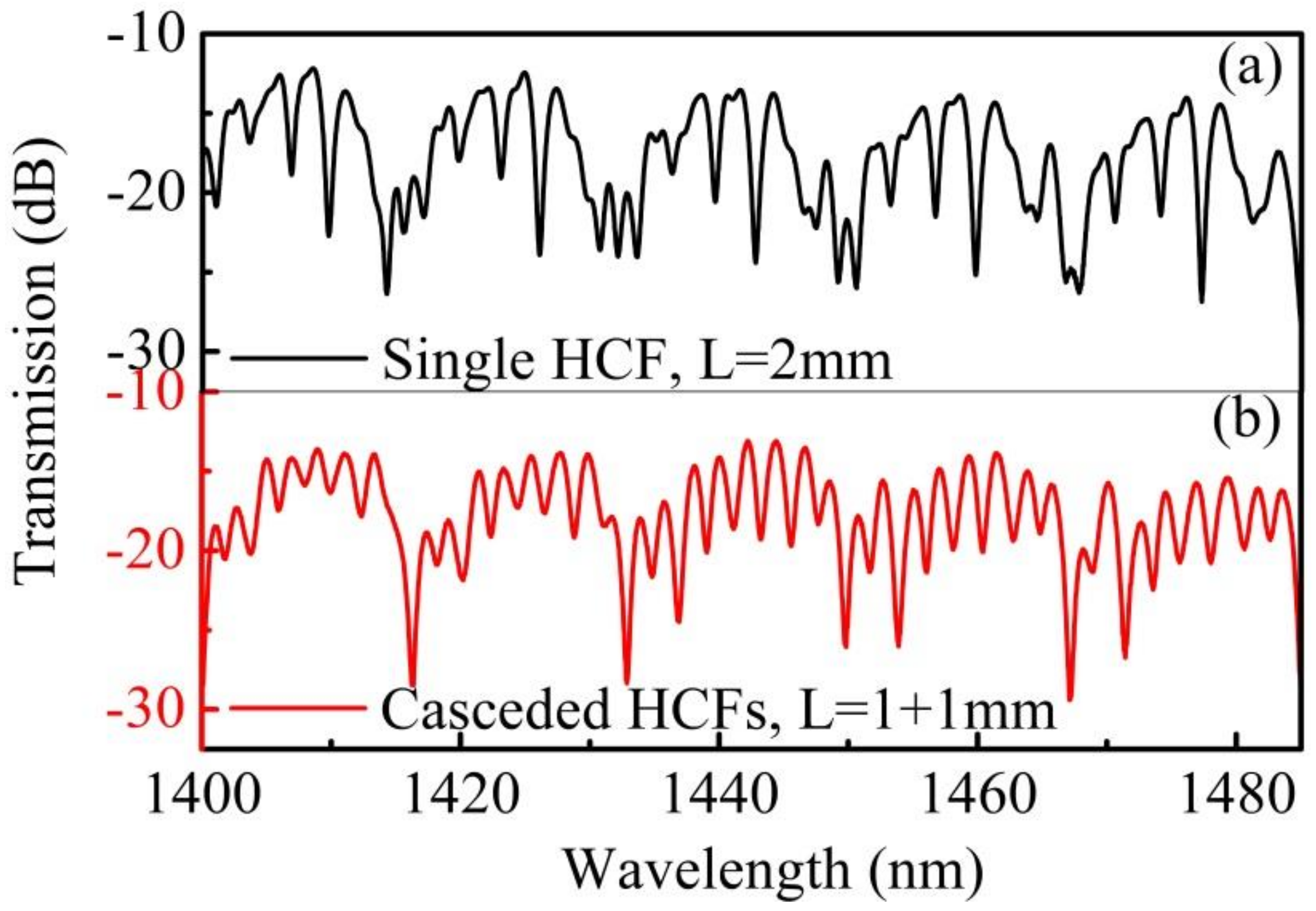

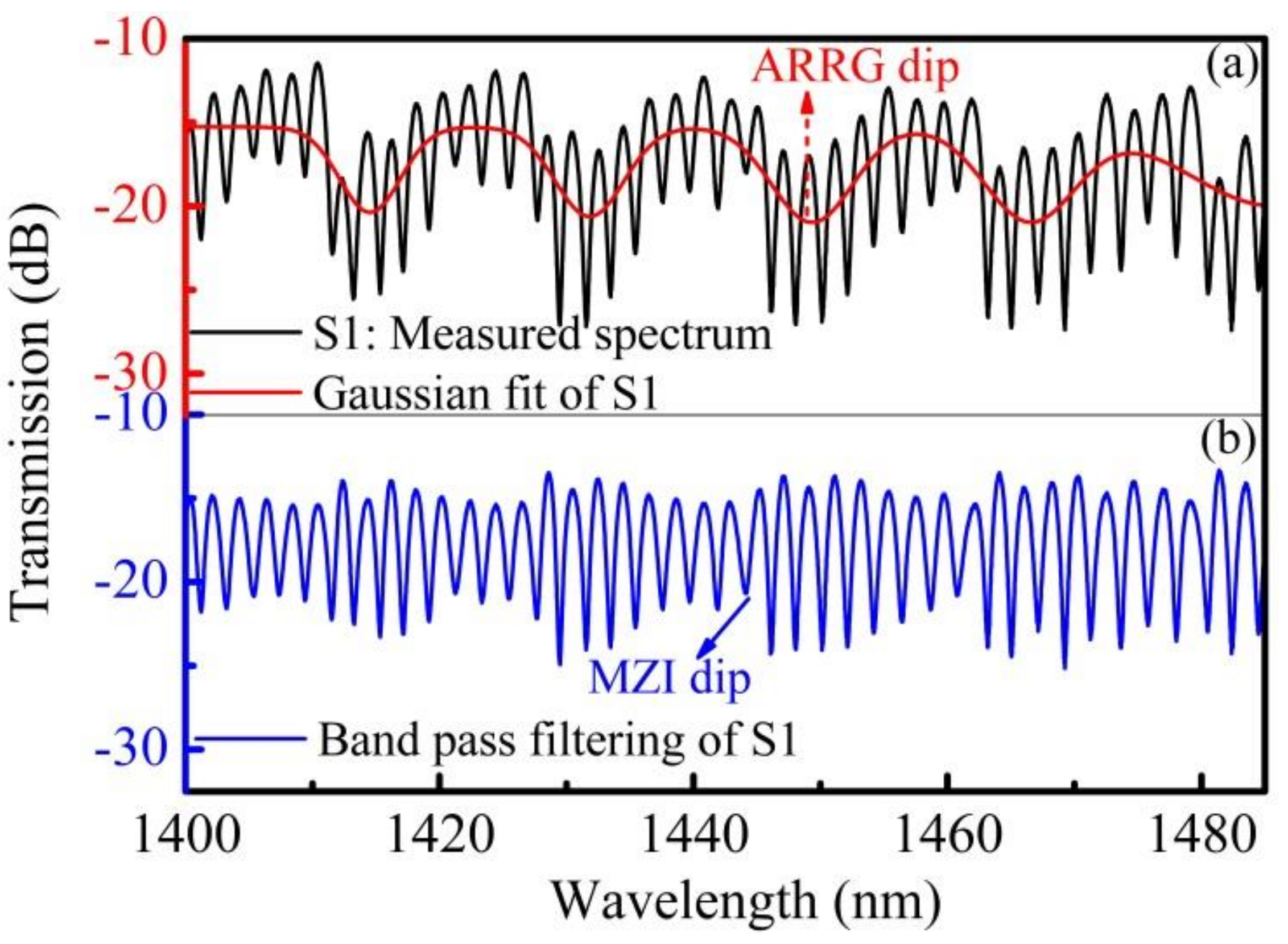

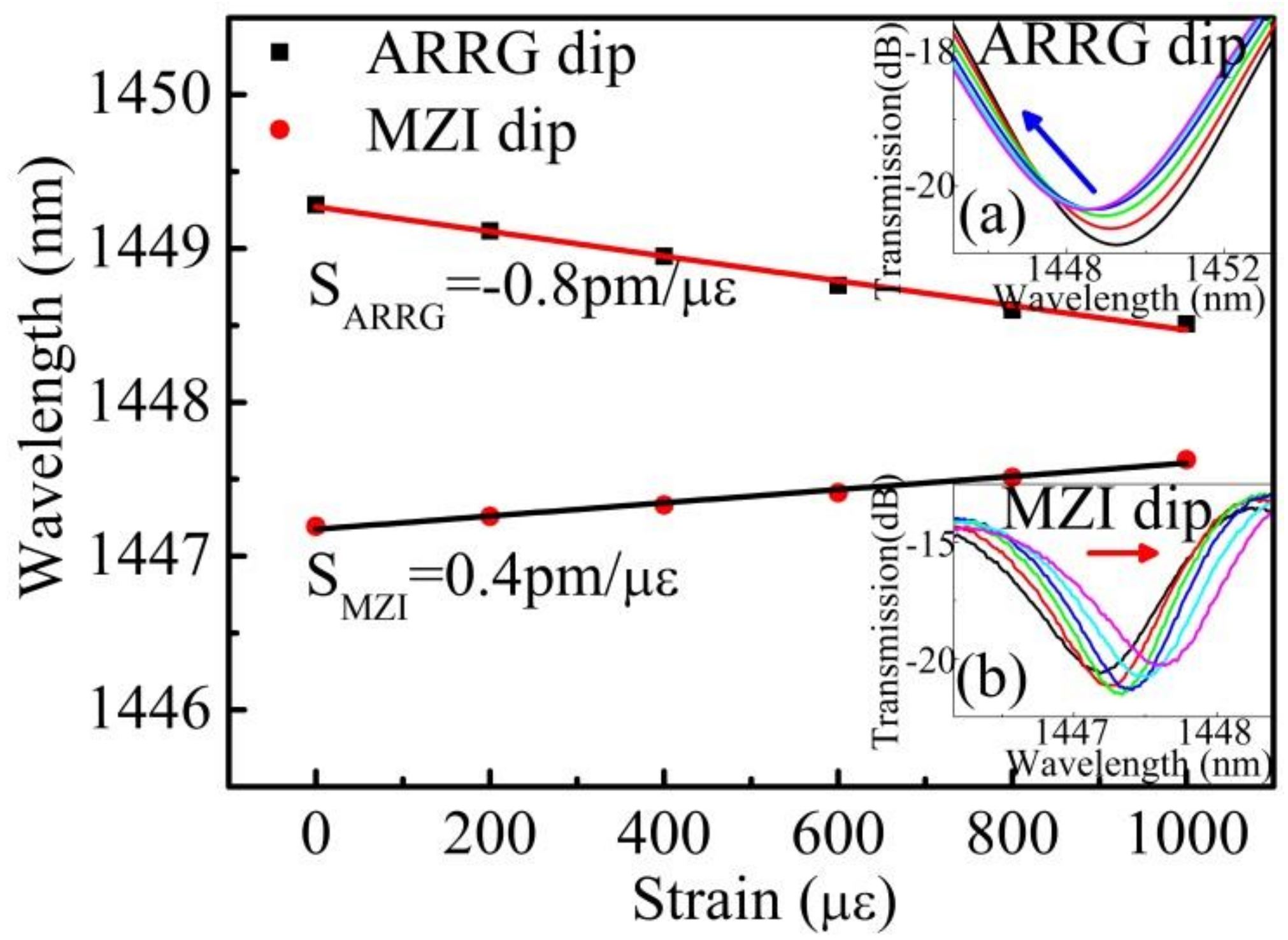
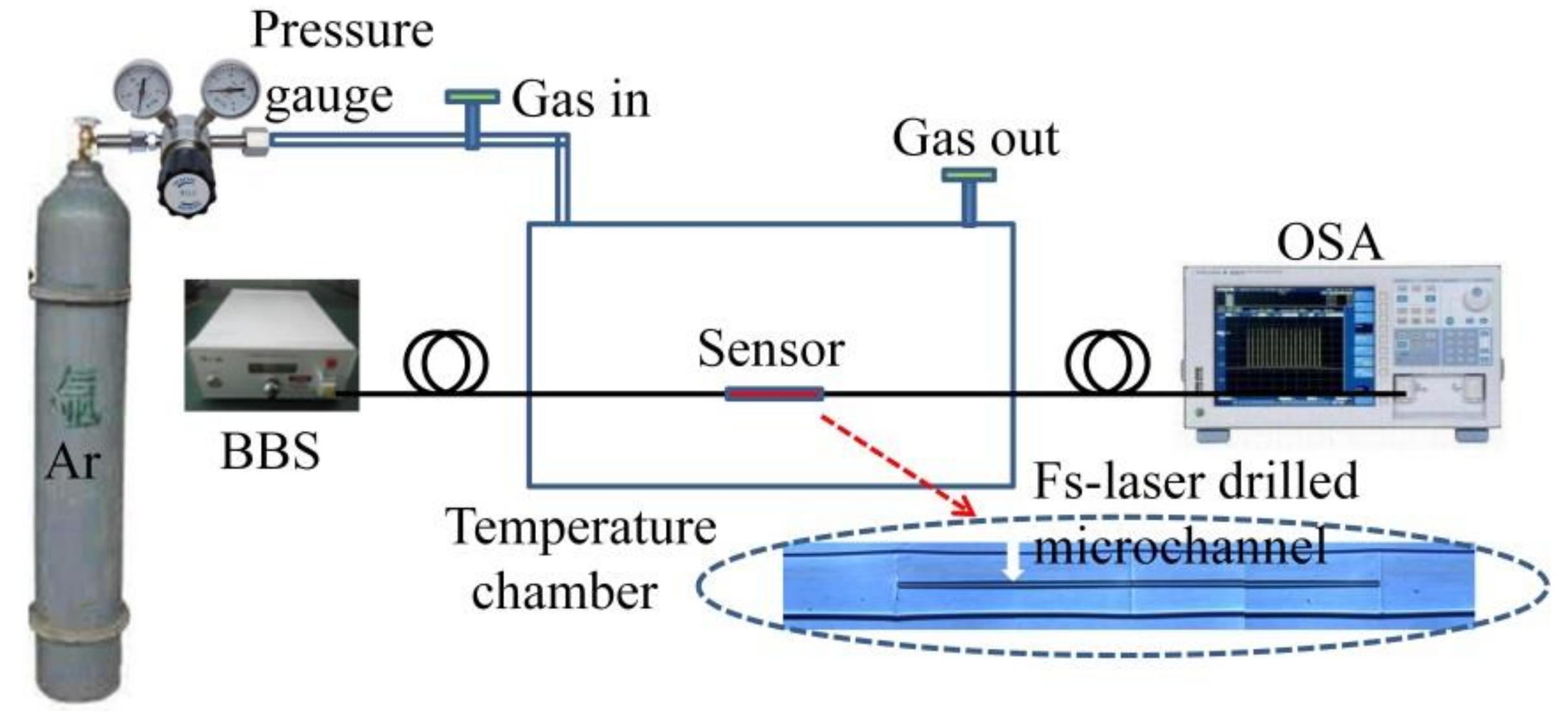
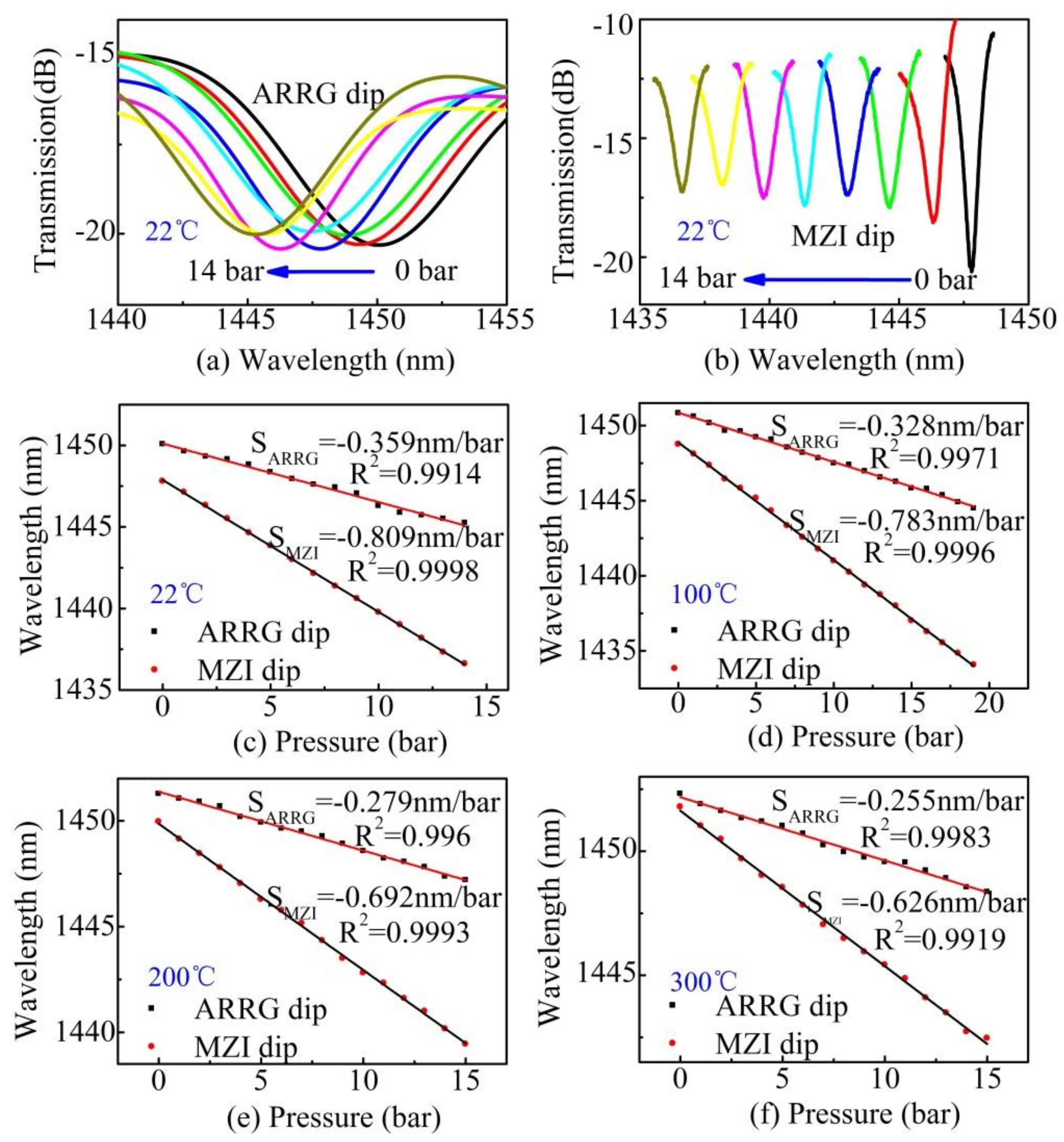
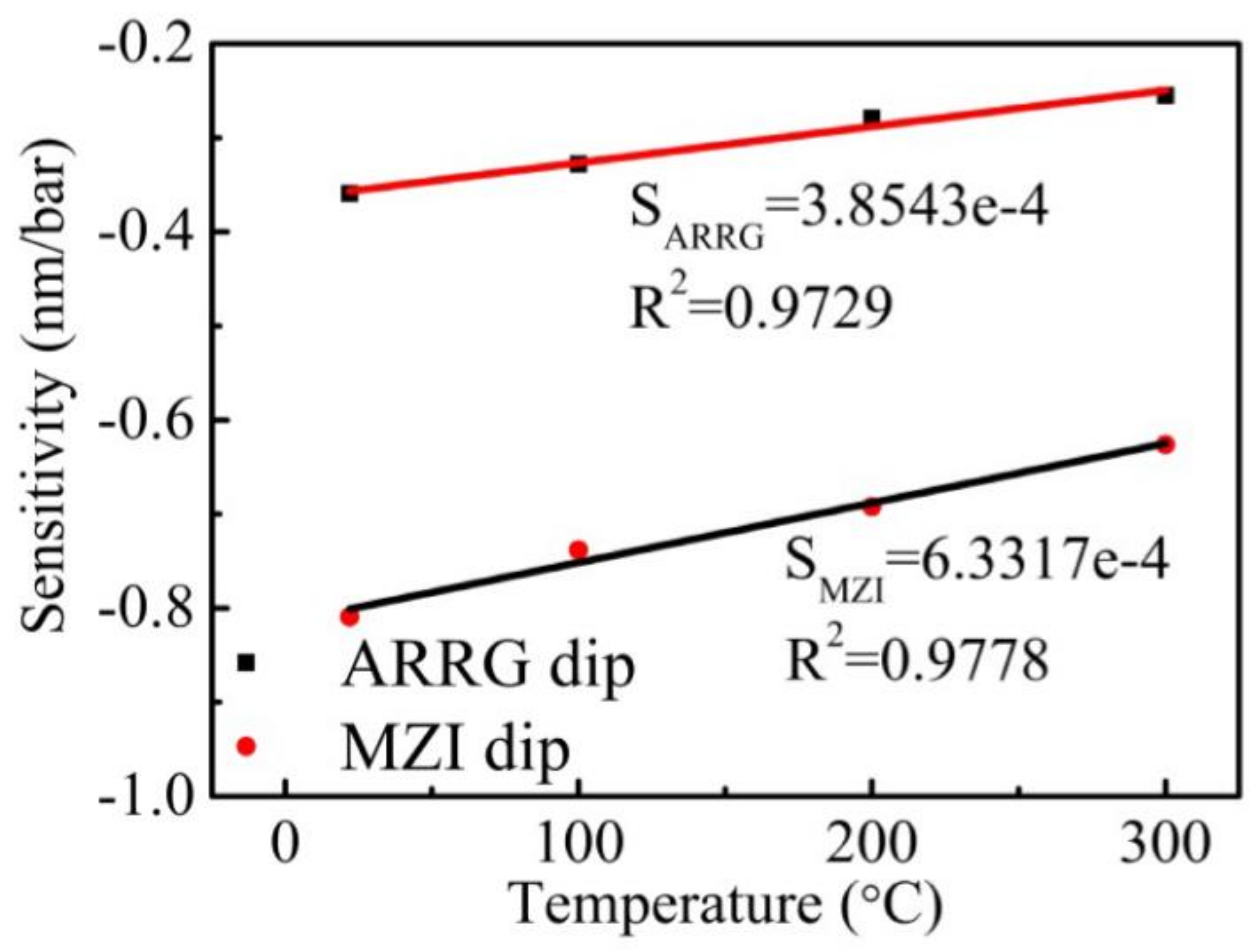
© 2018 by the authors. Licensee MDPI, Basel, Switzerland. This article is an open access article distributed under the terms and conditions of the Creative Commons Attribution (CC BY) license (http://creativecommons.org/licenses/by/4.0/).
Share and Cite
Hou, M.; He, J.; Xu, X.; Li, Z.; Zhang, Z.; Guo, K.; Ju, S.; Wang, Y. Antiresonant Reflecting Guidance and Mach-Zender Interference in Cascaded Hollow-Core Fibers for Multi-Parameter Sensing. Sensors 2018, 18, 4140. https://doi.org/10.3390/s18124140
Hou M, He J, Xu X, Li Z, Zhang Z, Guo K, Ju S, Wang Y. Antiresonant Reflecting Guidance and Mach-Zender Interference in Cascaded Hollow-Core Fibers for Multi-Parameter Sensing. Sensors. 2018; 18(12):4140. https://doi.org/10.3390/s18124140
Chicago/Turabian StyleHou, Maoxiang, Jun He, Xizhen Xu, Ziliang Li, Zhe Zhang, Kuikui Guo, Shuai Ju, and Yiping Wang. 2018. "Antiresonant Reflecting Guidance and Mach-Zender Interference in Cascaded Hollow-Core Fibers for Multi-Parameter Sensing" Sensors 18, no. 12: 4140. https://doi.org/10.3390/s18124140
APA StyleHou, M., He, J., Xu, X., Li, Z., Zhang, Z., Guo, K., Ju, S., & Wang, Y. (2018). Antiresonant Reflecting Guidance and Mach-Zender Interference in Cascaded Hollow-Core Fibers for Multi-Parameter Sensing. Sensors, 18(12), 4140. https://doi.org/10.3390/s18124140






